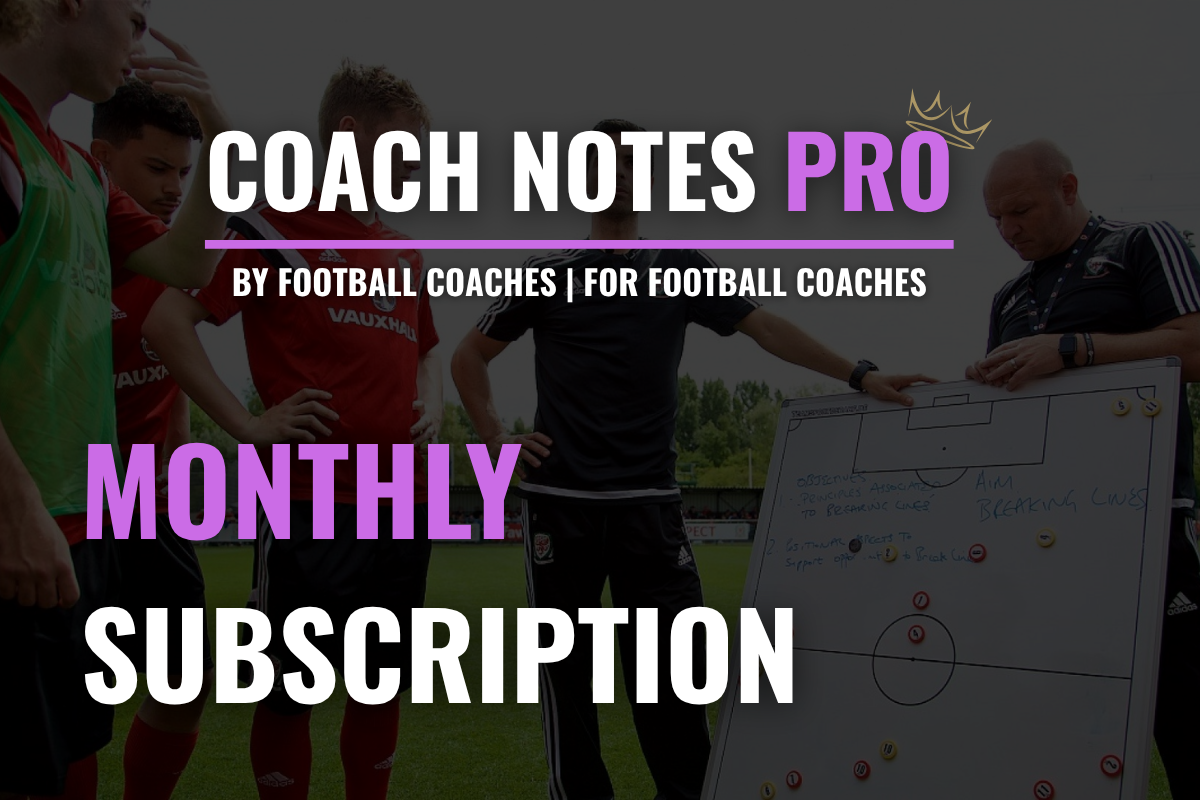
Attacking Midfielder Specific Coaching
This section features 8 key areas essential to developing attacking midfielders, each with tailored coaching tips and position-specific drills. Every skill is broken down to help strikers make better decisions and execute with confidence in 1v1 situations.
Receiving & Turning Coaching Tips
✅ Scan to Anticipate Pressure & Space
Attacking midfielders must constantly scan their surroundings before receiving the ball to assess where defenders are, how much space they have, and what their next action might be. The timing of these scans is critical, ideally just before the pass is played so the player can anticipate pressure and make quicker decisions. Teach players to look beyond their immediate defender and identify spaces to turn into or exploit.
✅ Receive on the Half-Turn to Face Forward
Positioning the body at an angle when receiving allows the midfielder to play forward with one touch, rather than being forced into a backward or square pass. This technique gives them a head start on breaking lines and turning quickly under pressure. Focus on drills that emphasise receiving side-on, with hips and shoulders open to the direction of attack, and on taking the first touch into space.
✅ Use the Back Foot to Open the Game Up
Receiving with the back foot (furthest from the passer) enables players to move away from pressure and access wider angles for the next action. This technique increases time on the ball and allows for smoother directional control. For example, a midfielder receiving a pass from the right should ideally take the ball with the left foot, enabling them to pivot into central or left-side channels with ease.
✅ Protect the Ball When Turning in Tight Spaces
When turning under pressure, body positioning becomes critical. Midfielders should use their arms and frame to shield the ball from defenders, especially when contact is imminent. Reinforce the importance of using small touches and maintaining a low centre of gravity to stay balanced while resisting challenges. Players should be encouraged to use the outside of the foot to shift the ball quickly while turning.
✅ Time Movement Between the Lines After Defensive Shifts
The best moments to receive between the lines are immediately after the opposition shifts defensively, either after pressing or when recovering shape. Midfielders must be coached to read these triggers and adjust their positioning to find pockets of space that emerge temporarily. This demands not just technical skill but tactical awareness and the discipline to remain patient until the right moment to check into the gap.
Passing Forward Coaching Tips
✅ Scan Early and Continuously to Build a Mental Picture
Effective forward passing begins before the ball is even received. Encourage players to scan not only their immediate surroundings but also beyond the defensive line - looking for runs, space, and potential passing lanes. The best attacking midfielders scan multiple times within a few seconds before receiving, allowing them to build a real-time mental map of moving targets and pressure. Scanning after the pass is already on the way is often too late - train the habit of before-ball awareness.
✅ Play Between Lines, Not Just to Feet
True progression occurs when passes break lines - playing into space between defenders rather than simply finding a teammate’s feet. Midfielders should be trained to recognize when to play third-line passes (past the midfield and defensive lines), using disguised angles and timing to hit forward-facing teammates in stride. Encourage the use of firm, incisive passes that allow the receiver to continue the attack fluidly without needing to stop and control.
✅ Disguise Passes to Deceive Defenders
Midfielders with top-level vision often use subtle body cues to disguise their intentions, shaping to play one way while passing another. This helps to unbalance defensive lines and slip balls into runners who might otherwise be tightly marked. Teach players to use their eyes, body shape, and foot positioning to sell a different action for example, looking square but sliding the ball between centre backs into a striker.
✅ Break Lines with Timing, Not Just Technique
Not every forward pass needs to be made as soon as it becomes available. Encourage midfielders to recognise when a pass will hurt the opposition - usually just before a teammate makes their movement, or when a defender is out of position. Playing the pass too early or too late can make even a technically good ball ineffective. This requires synchronising vision with tactical awareness and movement cues from teammates.
✅ Use Different Types of Passes for Different Scenarios
Mastery of forward passing includes the ability to vary pass type based on pressure, space, and teammate positioning. Examples include:
- Driven passes through tight channels
- Lofted passes over defensive lines
- Reverse passes against the grain of the defender’s movement
- Bent passes around the outside using the instep
Coaching should emphasise when and how to use each pass type, as well as how to adjust weight and spin to make them executable under pressure.
Dribbling Coaching Tips
✅ Dribble with Purpose, Not for Possession
Attacking midfielders must understand that dribbling is not just about ball retention, it’s a tool to create space for themselves, teammates, or to destabilise defensive units. Every dribble should have an intention: to attract pressure and release, break a line, or create a passing or shooting lane. Encourage players to identify what they’re trying to achieve before initiating a dribble, and to scan before and during to adjust accordingly.
✅ Use Changes of Pace and Direction to Unsettle Defenders
Static dribbling is ineffective at higher levels. Teach players to manipulate tempo, slow the defender down with controlled touches, then accelerate explosively past them. Combine that with sharp changes in direction (using inside/outside foot cuts, chops, and feints) to wrong-foot defenders and carve out angles to play forward. Emphasise acceleration after the move as the moment to exploit the gap created.
✅ Protect the Ball While Driving Forward
While dribbling at defenders, attacking midfielders must also be masters at shielding the ball. Encourage use of the arm to hold off pressure and body positioning to place the ball farthest from the defender. Midfielders should practise driving with a slightly lower centre of gravity, using short, controlled touches with the laces to maintain close control, especially in central areas where turnovers can be costly.
✅ Create Separation with Quick Double Actions
In tight areas, a single movement is often not enough to create space. Encourage the use of double actions, such as a step-over followed by a push into space, or a body feint followed by an outside cut. These combinations make it harder for defenders to read and recover, giving the attacker a brief window to shoot, pass, or carry the ball forward. Players should work on executing these under pressure in tight grids and directional drills.
✅ Use Dribbling to Draw Opponents and Release Teammates
Dribbling centrally can attract multiple defenders, especially in compact midfields. When done correctly, this forces opposition players out of their shape, opening up passing lanes and overloads elsewhere. Train midfielders to recognise these moments and release the ball at the right time. Delaying the pass too long eliminates the advantage. Use rondo-based positional games to reinforce the timing of when to dribble and when to offload.
Shooting from Distance Coaching Tips
✅ Prioritise Technique
Striking from distance requires clean contact more than raw power. Encourage players to focus on consistent technique: non-kicking foot beside the ball, body slightly over it, and striking through the centre or lower half of the ball with the laces. Reinforce the importance of staying compact through the strike to avoid leaning back, which often leads to shots rising over the bar.
✅ Set the Ball to Shoot
Creating the shot opportunity often depends on the quality of the first touch. Attacking midfielders must practise setting the ball out of their feet at the correct angle and distance to allow a fluid strike without breaking stride. Whether after a pass or following a dribble, this touch should prepare the ball away from pressure and into their shooting line - typically a diagonal touch out of the body.
✅ Target the Corners and Use the Bounce
Finishing from range is most effective when placed low into the corners or when bouncing just before reaching the goalkeeper. Midfielders should practise striking low-driven shots that skip off the turf, particularly on slick or wet surfaces. This makes saves more difficult and increases the chance of rebounds. Encourage variation, high power is less important than deception and precision.
✅ Use Defenders as Visual Screens
Players should be coached to shoot through or around defenders to block the goalkeeper’s line of sight. This makes it harder for keepers to judge the ball’s flight or set their feet in time. Reinforce the importance of using defenders as “screens” either by bending the ball around them or driving it low past them on the blind side.
✅ Recognise the Right Moment
Attacking midfielders must learn when the shooting window is truly open. This often follows a clearance, a switch of play, or a lay-off at the top of the box. Rushing shots when space or balance isn’t right leads to poor outcomes. Teach players to scan for recovering defenders, assess the goalkeeper’s positioning, and commit only when they’re in control, not just when they’re in range.
Arriving in the Box Coaching Tips
✅ Time Runs Based on Triggers
The key to arriving unmarked is reading triggers, not reacting to the ball. Attacking midfielders must learn to recognise when a wide player is shaping to cross, when a striker pins a defender, or when the ball-carrier lifts their head. These are cues to begin the movement, not when the ball is already on its way. Training should focus on movement in sync with teammates' actions, not just ball travel.
✅ Delay the Run to Create Separation
Rather than sprinting into the box too early and becoming tracked, players should learn to arrive late. A slight hesitation outside the box allows defenders to be drawn deeper toward the goal, opening space at the edge or penalty spot. Coaches should simulate scenarios where players hold their run briefly before attacking the space at pace, often arriving as the ball arrives, not before it.
✅ Arrive with Speed and Intent
Arriving into the box is not just about being in the right place, it's about how you get there. Players must accelerate into the space to attack the ball with purpose, whether for a cutback, rebound, or second ball. Arriving flat-footed or standing still greatly reduces finishing chances. Reinforce the need for a final sharp burst and an athletic, front-footed body shape to finish cleanly.
✅ Adapt Movement to Opponent’s Defensive Line
Attacking midfielders must vary their movement depending on how the opposition defends. Against a zonal setup, players should look to attack gaps between defenders or arrive at the blind side of a midfielder. Against man-marking, disguise and double movements (e.g. checking away then darting in) can create separation. Train these reads through functional small-sided games with realistic defensive structures.
✅ Arrive in ‘Scoring Zones’
Emphasise that simply entering the box isn’t enough. Players should target specific high-value areas, such as:
- The penalty spot (for cutbacks)
- Edge of the six-yard box (for low whipped crosses)
- Second post (for late runs when the far-side defender ball-watches)
- Edge of the box (for rebounds or second-phase strikes)
Sessions should train players to recognise these zones and arrive in them consistently based on the type and location of delivery.
Combination Play Coaching Tips
✅ Think One Step Ahead – Pass and Move with Intent
Combination play only works when players are proactive, not reactive. Encourage attacking midfielders to think beyond their next touch to visualise the sequence. After playing a pass (e.g. into a striker’s feet), the player should move purposefully to receive again, often into space behind a marker. "Pass and stand" kills rhythm. Use drills that reward immediate second movements (e.g. third-man runs, give-and-go, wall passes).
✅ Minimise Touches to Increase Tempo
In tight spaces, time is limited. Teach players to use minimal touches ideally one or two - to keep play sharp and untrackable. First-time lay-offs, flicks, and touches around the corner should be practised regularly. Midfielders must get comfortable releasing the ball quickly and trusting teammates to execute the next phase. This requires rehearsing in high-pressure, high-tempo rondos and zone-based possession drills.
✅ Use Disguise and Deception
In tight areas, defenders are watching every movement. Using body shape to sell one action while doing another can create decisive gaps. For example, shaping to pass backwards before slipping a reverse pass through, or disguising a layoff by opening up like they’ll shoot. Midfielders should be coached to use eyes, hips, and shoulders as tools of deception. Drills should include constraints that encourage disguise and misdirection.
✅ Establish Relationships and Patterns with Teammates
Combination play relies heavily on familiarity and timing. Encourage consistent training patterns between attacking midfielders, strikers, and overlapping full-backs. Train recognisable triggers e.g. striker drops in, midfielder runs beyond to create chemistry and automated responses. Small-sided positional games with repetition help build these patterns under realistic conditions.
✅ Stay Compact in Body Shape – Be Balanced and Mobile
In crowded spaces, physical balance is essential. Teach players to adopt a slightly lower centre of gravity, with knees flexed and weight on the balls of their feet. This allows for quick pivots, sharp touches, and explosive changes of direction. Body shape should always allow for scanning before receiving, and the ability to pass in multiple directions without needing to reset.
Pressing Coaching Tips
✅ Anticipation & Pressing Cues
Elite pressing midfielders anticipate where the ball will go before it gets there. Train players to read triggers such as poor touches, backward passes, or isolated receivers. Pressing should start as the ball is travelling, not after it has arrived to deny time and space. Sessions should include pattern recognition: when to jump, when to screen, and when to hold.
✅ Counter-Press Immediately After Losing Possession
When possession is lost, the first 3–5 seconds are critical. Encourage a mindset of immediate re-engagement rather than retreat. Midfielders closest to the ball must close space aggressively, while supporting players compress around them to win second balls. This coordinated response disrupts the opponent’s counter and regains control high up the pitch. Use transition-based small-sided games to engrain this habit.
✅ Control Body Shape and Press from the Correct Angle
Pressing isn’t just about intensity - it’s also about angles. Attacking midfielders must approach with their body slightly side-on to funnel the play, cut passing lanes, and reduce options. Poor pressing angles allow easy escapes. Train players to press in curved runs that show the ball into compact areas or weaker feet, rather than straight-line sprints that offer no control.
✅ Press With the Purpose of Regaining
Mindless pressing gets bypassed. Smart pressing isolates targets and forces predictable passes that teammates can intercept or press themselves. Encourage players to press to win, not just to disrupt. That includes recognising when to tackle, when to block, and when to delay. Design drills with numerical superiority for defenders unless the press is perfectly timed and directed.
✅ Mentally Rebound After Loss of Possession
The best transition players switch from attacking to defending instantly without frustration or delay. Train players to develop a mentality of “next action” immediacy. As soon as the ball is lost, the focus must shift to closing the nearest passing lane or applying pressure. Use high-tempo drills where turnovers are constant, and reward teams for recovering possession within seconds of losing it.
Supporting Build Up Coaching Tips
✅ Create Angles
Attacking midfielders must understand how to offer passing lanes that help the ball-carrier, not just receive the ball in space. It’s not about being available, it’s about being usefully available. Emphasise the creation of diagonal angles rather than standing behind markers or staying in flat lines. Movement should be constant to adjust positioning based on the ball’s location, teammate pressure, and potential traps from the opposition.
✅ Scan Before You Show
Encourage players to scan multiple times before receiving. Knowing the positioning of teammates, opponents, and space allows for quicker and cleaner decisions when supporting build-up. Drills should focus on receiving under passive and active pressure, with emphasis on checking shoulders before stepping into passing lanes or turning. Use freeze-frame coaching to check players’ awareness habits.
✅ Play on the Half-Turn to Face Forward When Possible
Teach attacking midfielders to receive with hips open not square, especially when between lines. This “half-turn” posture allows for immediate progression if pressure is light. When turning isn’t possible, the next best action is a controlled bounce or wall pass to keep the tempo high. Train players in recognising pressing cues to determine whether to turn, hold, or play one-touch.
✅ Use Minimal Touches to Maintain Flow
In build-up play, time and rhythm matter. Players should be coached to reduce unnecessary touches, ideally playing off 1 or 2 - to help the team move fluidly. Sessions should simulate compact midfield setups where ball speed and positional discipline are key. Practise “rondo plus” games with targets where the midfielder must bounce, switch, or recycle under time constraint.
✅ Be the Link, Not the End Point
The attacking midfielder’s role in build-up is not always to create immediately, but to connect phases of play. Reinforce the concept of being the “bridge” between holding midfield and attacking runners. They must identify when to circulate, when to accelerate play, and when to draw defenders to free others. This role requires patience, vision, and trust in teammates, all of which should be embedded through high-tempo, directional possession games.

































